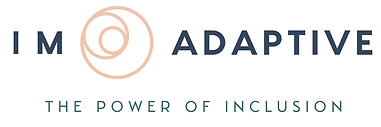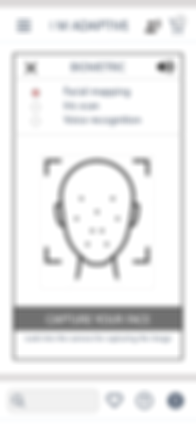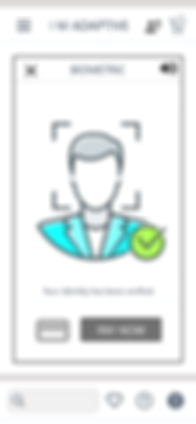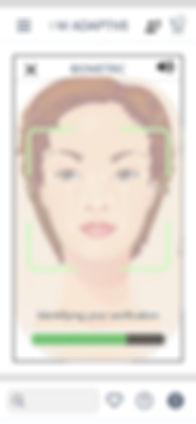
Adaptable Clothing Brand
People with limited mobility
Case Study Done During the Google certification
Project duration:
October 2023-November 2023
The Product:
Inclusive Clothing E-commerce Platform is an online marketplace for adaptive clothing and accessories. It caters to the needs of individuals with disabilities, limited mobility, and specific dressing requirements.
The platform emphasizes accessibility, comfort, and style to promote inclusivity and empower individuals to express their personal style while addressing their specific needs.


Project Overview
The Problem:
Individuals with limited motor skills struggle to find fashionable clothing that fits their unique needs.
Existing options lack accessibility, and the physical act of shopping can be difficult.
A custom clothing app is needed that empowers users to explore, design, and acquire clothing tailored to their requirements. The app must integrate with assistive technology to promote inclusivity and enhance users' quality of life.
The Goal:
My goal is to create a custom clothing app that will enable individuals with limited motor skills to express themselves through fashion independently.
The goal is to make fashion inclusive and accessible to everyone, regardless of physical abilities or age. My commitment is to provide diverse options and break down barriers so that everyone can feel confident and comfortable in their clothing choices.

My Role:
My role in this project include:
UX research, UX interaction and UI design
Tasks worked on
-
Conduct UX research
-
Find users’ pain points.
-
Generate ideas.
-
Prototype
-
Conduct usability testing
-
User personas
-
Customer journey maps
-
Problem statements
-
Paper prototypes
-
Wireframes
-
High-fidelity
-
Finding insights
Flexibility in Approach
"The new way to adaptability"



Understanding the User

User Research Summary:
Based on the NIDILLRR Annual report, the percentage of people with limited mobility in America was 13.2% in 2019, and it has increased to 13.5% in 2021. This indicates that there has been a rise in the number of people who require clothing accessibility.
The study aimed to develop an adaptive clothing brand for people with disabilities. Their needs vary significantly and require a broad range of adaptive clothing options. User-centric approach, personas and accessibility standards were used to cater to different disabilities and preferences and ensure the brand's online presence is accessible to all users.
Who are the Users ?

-
Individuals of all ages with disabilities, including those with limited mobility or sensory sensitivities.
-
Caregivers, family members, and friends looking to support and purchase clothing for their loved ones.
-
Medical professionals, occupational therapists, and healthcare organizations seeking adaptive clothing solutions.
-
Anyone who values inclusivity and accessible fashion options.
Benefits:
-
Empowers individuals to dress with ease and confidence.
-
Promotes inclusivity and independence.
-
Reduces the frustration associated with traditional clothing.
-
Provides a wide range of stylish clothing options.
-
Enhances the overall quality of life for users and caregivers.
Challenges:
-
Limited Accessibility: The existing fashion industry fails to address the needs of individuals with disabilities, leaving them with limited options and frustrating shopping experiences.
-
Diverse User Needs: Our research revealed a diverse range of user needs, including easy-to-wear clothing, stylish options, age-appropriate designs for children, and compatibility with assistive technology.

Personas Developed

Problem statement:
Sarah, an elderly woman with limited motor skills struggles to find stylish, comfortable clothes designed for people with limited dexterity.

Problem statement:
John, an older man with mobility issues due to aging, struggles to find stylish and comfortable clothing. Lack of adaptive clothing options for seniors makes it hard for him to maintain a dignified appearance.

Problem statement:
Lily, a young girl with a partial left leg amputation, struggles to find fashionable and comfortable clothing that meets her specific needs due to the limited availability of adaptive clothing options for children with amputations.






Empathy Maps
Pain Points of the Personas
Navigation and Layout:
-
Confusing menu structure.
-
Difficulty in finding specific clothing categories.
-
Small font size and unclear labeling.
Accessibility Features:
-
Incomplete keyboard navigation support.
-
Limited integration of assistive technologies.
Checkout Process:
-
Complex and lengthy checkout steps.
-
Limited payment options for user
-
No option for voice command checkout.
Fashion Relevance:
-
Limited representation of diverse models.
Technical Aspects:
-
Need for responsive design for various screen sizes.
User Experience
-
Frustration expressed by users with disabilities.
-
Dissatisfaction with the overall shopping experience.
-
Desire for a more personalized and inclusive platform
-
Enthusiasm for the potential of adaptive fashion.
Proposal
-
Adhere to web accessibility standards.
-
Enhance navigation with clear labels and intuitive menus.
-
Expand the range of adaptive clothing options and customization features.
-
Simplify the checkout process and offer multiple payment options.
-
Diversify model representation and prioritize inclusive fashion.

How Might We
HMW make the website's navigation and interface so intuitive that even users with severe motor limitations can easily find and interact with our content and products?
HMW leverage assistive technologies and alternative input methods to make the website accessible to those who rely on them?

Comparative Analysis


Tommy Hilfiger and IZ Adaptive offer adaptive clothing for all ages with fashion in mind, while No Limbits and Sliverts specialize in specific niches.
I did audit of the few competitors in the market to get an idea of the gaps and opportunities to address while designing the app.
Various Adaptable Clothing Brands in the Market
What can be Improve further
-
Easy Payment Options
-
Dedicated Adaptive Clothing website for people of all ages and genders
-
Custom Tailoring Services
-
Inclusive Product Line
-
Less Scrolling Pages
-
Diverse Representation
-
User Support and Guidance
What need to Adapt from them
-
Large Text and Clear Typography
-
Intuitive Navigation
-
Clear Calls to Action
-
Assistive Technology Compatibility
-
Feedback and Contact Options
-
Efficient Product Filtering
-
Responsive Design
-
Accessible Design
-
Inclusive Imagery
Starting a Design
Ideation process

Initial digital wireframes
Usability Study-Parameters
Usability Study:
Enhancing Accessibility and Inclusivity in Online Clothing Shopping
Introduction:
This usability study aims to evaluate the user experience of an e-commerce clothing website with a focus on improving accessibility and inclusivity.
Study Type: Unmoderated Usability Study
Location: United states of America
Participants: 5
Ages: 7 to 70 years old
Key usability study parameters:
1. Learnability: How easy is it for users to navigate and shop on the platform, including those with disabilities?
2. Efficiency: How quickly and efficiently can users perform common tasks?
3. Effectiveness: How successful are users in achieving their goals? Are there any obstacles?
4. Satisfaction: What is the overall user satisfaction with the platform's design, accessibility, and functionality? Any areas of improvement?
5. Accessibility: Assessing the platform's compliance with accessibility standards and effectiveness in accommodating users with disabilities.


Key Insights
Priority 0
1. Based on the theme that:
Users with limited motor skills face difficulty searching, tapping, checking boxes, and scrolling.
An insight is:
For users with limited motor skills, navigating through websites can be challenging. To make it easier, it would be helpful to have the option to navigate using voice commands or skip to the content directly. This way, users can access the information they need without struggling with buttons or checkboxes.
2. Based on the theme that:
Sometimes, users accidentally add or select items because of unintentional touches,
An insight is:
There should be an option to deselect items or confirm before adding them to the cart
Priority 1
1. Based on the theme that:
They are unable to zoom in on images to view clothing details
An insight is:
Users would be helpful to have an icon for zooming in on selected images or dragging them over.
2. Based on the theme that:
The user wants a Wishlist or add to favorite option.
An insight is:
Provide an intuitive and easily accessible option, such as a heart icon or "Add to Favorites" button, on each product listing. Users can tap this button to add items to their Favorites.
Priority 2
1. Based on the theme that:
Users need an easy way to address custom tailoring clothes according to user’s measurement
An insight is:
Provide a virtual fitting room function that enables users to input their measurements and see how selected clothing items will look on their bodies before buying. Also, create a measurement profile section where users can save and manage their specific measurements within the app. This profile should include detailed measurements such as chest, waist, hips, inseam, sleeve length, and more.
2. Base on the theme that:
Unfortunately, there is no option available for a personalized recommendation based on individual preferences and style.
An insight is:
Allow users to create profiles where they can input their style preferences, clothing sizes, favorite colors, and other relevant information. This could be done during the onboarding process or in the user settings
Rethinking a Design
Digital Wireframes



-
Easy Clear Navigation by categorizing users into Men, Women & Kid on Home page.
-
Clear call to action buttons.
When designing wireframes, I prioritized user needs by keeping navigation simple and easy while seamlessly integrating with various assistive technologies, including screen readers, voice commands, eye-tracking devices, and more.
I focused on providing one-click easy accessibility options to the users since landing on the Home page.
Accessibility to
-
Voice-command option
-
Accessibility Technology tab
-
Wishlist
-
Customer Support
-
Sort & filter
-
Shopping Cart
-
Search Bar
-
Menu option



Biometric payment Options
-
Facial mapping
-
Iris Scan
-
Voice Recognition
Easy Payment includes
-
Multiple Payment Options
-
Saved Payment Information
-
Simplified Checkout Form
-
Payment Confirmation
Menu bar includes
-
Navigation through categorization
-
Account accessing
-
Accessibility Guide
-
Getting help
-
Sign in/Out
Accessibility includes
-
Content Scaling
-
Text Size
-
Letter Spacing
-
Highlighting
-
Color Adjustment
-
Orientation Adjustment
-
Language
-
Text-to speech
-
keyboard mode
-
Skip to content.








Different ways to do payments.
Responsive design allows websites to reach a broader audience by ensuring an optimal viewing experience regardless of the device being used.

High-Fidelity Mockups




Takeaways
Through embracing inclusivity, adhering to accessibility standards, and continuously seeking user feedback, an adaptive clothing brand and website can make a significant impact on the lives of individuals with limited motor skills and disabilities, empowering them with stylish and accessible clothing options.
I have learned that usability studies and gathering feedback are crucial in refining the mockup. These insights help me, as a designer, improve the product and keep the user at the forefront of the design process. It is important to remember that we are not the users, which is why we must continuously learn from them to create inclusive design.





